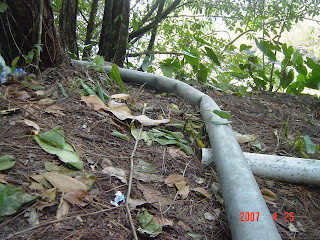
These falls run about 600 feet down the mountain. The reservoir that feeds the pipe that runs down the mountain is at the top in the trees.

The feeder tube is in the concrete casing to the left of the picture. The pipes sticking out the front of the cement retaining wall are used to adjust the water level in the reservoir.

You can see how steep this hill is by looking at the different levels of the men’s heads. They’re all standing, just a few feet apart on the trail. The vertical PVC pipe is filled with concrete and is used as a support for the galvanized pipe.

The pipe reinstalled heading down the hill, waiting to be hooked up to the feeder. The section of pipe after the one in this picture heads straight down the mountain about 800 feet so the water has enough pressure to make it up and over the mountain you can see in the background of this picture.

To make sure they’re getting more water pressure through the pipe, they would periodically open the valve and time how long it took to fill a five gallon bucket. Tom said it took less than 3 seconds.

It takes lots of hands to get the two ends of the pipes lined up to be reconnected.

Tom said there was only one guy strong enough to use the wrench to get the pipes hooked together so they wouldn’t leak, and even he didn’t always get it on the first try.

To soften the PVC pipe to bend it, they built a fire on the hillside. This fire worked, Tom said, but another one ended up splitting the pipe.

Tom had the honor of sawing the heavy metal pipe. He said the guys were very concerned that the cut was straight.

The pipe was heavy enough and the hill was steep enough that even a partial section of pipe required one guy pushing it up the hill while another pulled with a rope. If the pusher slipped, they didn’t want to lose the pipe down the hill, partially because it would be difficult to retrieve it, but also because it could hurt somebody on the way down. Julio, the crew chief, was very proud that they did the whole job without any injuries.

One of the sections of pipe they bent.
 A long section of bent pipe curving away through the trees.
A long section of bent pipe curving away through the trees.
Job done, the men retraced what Tom and Selwyn figure is 2 ½ to 3 miles of pipe through the jungle and back to the reservoir at the top, carrying their tools and extra supplies.


Tom said it took a little bit of coaxing to get the tired men to carry out the pipe bending apparatus, which they called “the sponge.”

The whole crew back at the top of the mountain, job done. Doesn’t this remind you of some of those old CCC photos displayed at parks like Watkins Glen where the CCC did such an incredible job making the natural wonder accessible to everybody? The job these guys did on the water line was of the same caliber.



No comments:
Post a Comment